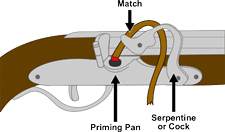- 01: Introduction
- 02: History
- 03: Propellants, Firearms, and Ammunition Development
- 04: Modern Firearms Manufacture
- 05: Small Arms Ammunition
- 06: Evidence Handling Procedures
- 07: Equipment and Instrumentation
- 08: Examination of Firearms
- 09: Cartridge and Shotshell Examination
- 10: Characterization and Evaluation of Fired Projectiles
- 11: Bullet Comparison and Identification
- 12: Gunshot Residue and Distance Determination
- 13: Toolmark Identification
- 14: Communicating Results
- Resources


Matchlocks
Home > Propellants, Firearms, and Ammunition Development > Evolution of Firearms > Ignition Systems > Matchlocks

Click for larger image
A metal rod, often in the shape of a gently curved “S,” held a match at one end and pivoted about the center. The opposite end from the match projected below the gun barrel where the operator could push or pull on it to cause the match to meet the touchhole. This class of firearms is called matchlocks. To allow the shooter to control and aim this firearm, the design of stock evolved to support the pivoting match holder. Illustrations of early matchlocks show the familiar form associated today with shoulder-fired small arms.
It is apparent that such a system would react slowly. To speed the firing process, designers conceived a spring-powered lock system. This system included the cock (the device that holds the match) and the trigger (a device to release the spring-loaded cock). To keep the firearm cocked, the shooter pulled back on the cock to store the spring’s energy and engage a notch in the cock with the trigger. A pull of the trigger released the cock a split-second later, and the match contacted the touchhole. Ultimately, the touchhole was moved to the side. A small pan was placed next to the touchhole to hold a charge of fine-grained priming powder, which improved ignition.
It is easy to imagine the difficulty of managing a matchlock in the heat of battle. The match could go out, requiring relighting with flint and steel (not an easy task in the days before disposable lighters). The system was practically useless in rainy weather. In spite of these serious shortcomings, cannon locks and matchlocks dominated the firearms industry for 150 years.




